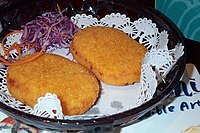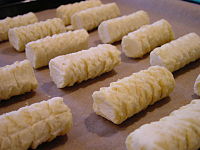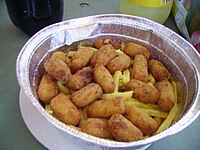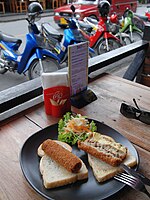Croquette
This article needs additional citations for verification. (January 2012) |
A croquette ( worldwide.
The binder is typically a thick béchamel or brown sauce, mashed potatoes,[3] wheat flour or wheat bread.[4] The binder may be mixed with or stuffed with a filling. Typical fillings include finely chopped meat, seafood, cheese, rice, mushrooms, and various vegetables, which may be combined with seasonings such as herbs and spices. Sweet croquettes may use a pastry cream binder and be filled with fruit.[5][6][7]
Croquettes may also be formed in other shapes, such as disks, ovals, or balls.
Etymology
The word croquette is French, derived from croquer, meaning 'to crunch'.[8] In the 18th century, it was typically spelled croquet.[7]
Origins
A 17th-century recipe for croquettes (croquets) by
Asia
India

A potato-filled croquette called
Sri Lanka
There are two main types of croquettes in Sri Lanka.[15] The first type is called rolls, and is a popular cylindrical bakery product. The rolls are commonly filled with a mixture of fish, potatoes and spices, and hence called fish rolls. Chicken is also sometimes used. The second type is called cutlets, which are spherical and generally made for festive occasions.
China
Japanese-style croquettes (kělè bǐng 可乐饼) are popular in China.[16] They are made with mashed potatoes, corn, and sometimes meat.
Indonesia
The recipes Indonesia (Dutch), made of mashed potato filled with minced chicken or ragout, is one of the most popular snack items in Indonesia, introduced during Dutch colonial rule.[17] The kroket is made by putting the chicken filling inside a mashed potato ball, which is then breaded and fried.
Japan
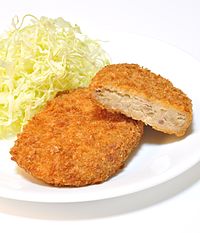
A relative of the croquette, known as
The dish likely was imported to Japan in the late 1800s along with other Western dishes.[19]
The town of Assabu, Hokkaido holds the Guinness World Record for world's largest croquette.[21]
South Korea
The Korean version of croquettes, goroke (고로케) or keuroket (크로켓),[22] are sold in many bakeries in South Korea. The most common type is deep-fried rolls stuffed with japchae (잡채) ingredients or chicken curry and mashed potato with vegetable salad. Goroke is sometimes filled with kimchi, pork, and bulgogi ingredients. Many Korean stores advertise the goroke as a French product and they are sold in most European-style bread stores in South Korea.
Europe
Belgium
This section's tone or style may not reflect the encyclopedic tone used on Wikipedia. (December 2018) |
Kroketten/croquettes can be served as a side or main dish. They are usually savoury and filled with mashed potatoes.[23] The two most popular Belgian croquettes have a thick bechamel filling mixed with grey shrimps "garnaalkroketten/croquettes de crevettes" or cheese "kaaskroketten/croquettes de fromage".[24] The prawn filling seems to have first appeared in 1922, and became popular in the 1950s.[25] As a main dish, they are usually served with a salad, fried parsley and frites.
France
The
They are traditionally made from a base of thick béchamel, velouté or potatoes purée in which different ingredients can be included (ham, cheese, meat, vegetables).[27] Croquettes made from a base of rice are also common and several recipes can be found in Antonin Carême books.[28]
Germany, Austria, and Switzerland

The German word is Kroketten (singular Krokette). In the German speaking countries, this usually refers to plain potato croquettes.[29] They are served as a side dish in restaurants but are also available frozen in supermarkets.
Hungary
Krokett is a small cylindrical croquette similar to the Czech variety: potatoes, eggs, flour, and butter, seasoned with nutmeg and salt and deep-fried in oil. This variety is available in most restaurants as a side dish and can also be bought frozen.[citation needed] When made with cottage cheese, they are called túrókrokett.[30]
Italy

In Italy, crocchette (known in the South as crocchè).
Ireland
Plain potato croquettes are available frozen or refrigerated in most supermarkets. They are also homemade, usually with the addition of chopped onion.
The Netherlands

After
The success of the croquette led to a whole series of food products resembling the croquette, but with other types of fillings, such as noodles, rice and

Broodje kroket, a croquette on a bread roll, is sold in restaurants, snack shops, and by street vendors. The popularity of the kroket in the Netherlands is such that even McDonald's sells their version on a bun as "McKroket".[37]
Poland
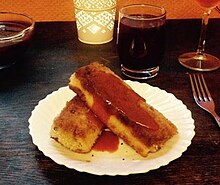
Croquettes in
Portugal
Croquetes
Russia
The widespread minced cutlet (Russian: котлета рубленная, romanized: kotleta rublennaya)[42] is made of minced meat (beef or pork or a mixture of both; chicken, turkey, or fish), bread, eggs, white onions, salt and spices, shaped as a meat patty and pan-fried. Bread is added in amounts up to 25% of meat, adding softness to the final product and also making it cheaper to produce. The Pozharsky cutlet is a well-known variety of such cutlets in which minced meat is mixed with butter.
Spain
Traditional croquetas[43] in Spain are made with thick béchamel. They are one of the most typical tapas dishes,[44] especially filled with jamón, chicken or salt cod.[45][46] Also, many bars and restaurants may offer novel, less traditional versions of croquettes with more varied fillings and ingredients such as apple, wild mushrooms, morcilla (blood sausage), cheeses, tuna,[47] cuttlefish (using its ink to give color and flavour), etc. Croqueterías are restaurants that specialize in croquetas.
United Kingdom
Croquettes[48] are available frozen[49] or refrigerated in most supermarkets, typically with potato filling.
Caribbean
Puerto Rico
Croquettes are typically made from ham, codfish or chicken
Cuba
Cuban croquettes are nearly identical to the Puerto Rican croquettes, in that they are also made from ham or chicken.[51] There is also a common cheese and potato variation, and they are sometimes made with fish.
Dominican Republic
Dominican croquettes are nearly identical to the Cuban and Puerto Rican croquettes, in that they are typically made from ham or chicken, but there is a common cheese and potato variation, a beef variation, and they are also sometimes made with fish.
Aruba
Aruban croquettes are commonly made with mashed potato, ground beef, shellfish, and fish. They are eaten as an early morning breakfast or as snacks any time of the day. They are considered one of the island's cultural foods.[52]
North America
Mexico
Croquettes are usually made of tuna or chicken[53] and potatoes. In southern Mexico, a variety is made with fresh cheese, plantain, and black beans.
United States
A
South America
Brazil
Croquetes,[58] primarily made from beef, are a common snack in many parts of Brazil.[59] The coxinha is a popular chicken-based croquette.[60]
Ecuador
From Riobamba, llapingachos are potato cakes with a cheese filling, fried in oil with achiote, and served with a peanut sauce.
Uruguay
Called "croquetas" in Spanish, the most popular stuffing are mashed potatoes (croquetas de papa), ham and mozzarella cheese (croquetas de jamón y queso), and rice (croquetas de arroz). Sometimes, the rice ones have herbs and little ham cubes. Generally, their shape is cylindrical and medium sized; but larger spherical ones also can be seen (especially with rice stuffing). They are deep-fried in oil.
Croquetas are very common: they are available in almost every bakery, supermarket or food shop, and many people cook them at home as a side dish or even a main dish. In modern restaurants, more sophisticated croquettes (e.g. with serrano ham and a mixture of cheese or salmon) usually come with a more elaborate sauce as a dip (e.g. sweet chili sauce) and are ordered as starters.
Colombia
In Colombia croquettes are commonly referred to as "papa rellena", which translates as stuffed potato. They consist of a mix of roughly mashed potato, seasoned shredded or ground beef and an egg. This mix is then lightly battered and deep fried. They are served in bars, casual restaurants, and at home for a celebration or party. They usually come with a side of homemade or bottled chili sauce.
Gallery
-
Circular croquettes
-
Cylindrical potato croquettes
-
Croquetas fritas
-
Two Dutch kroketten, one cut open to show the beef-ragout filling; Chiang Mai, Thailand
See also
- Krokettenmotie
- Cuchifritos – Various fried foods prepared principally of pork
- Bitterballen – Savoury Dutch meat-based snack
- Fritter – Fried pastry usually consisting of a portion of batter with a filling
- List of deep fried foods
- List of potato dishes
- Rissole – European dish of meat covered in pastry
- Chicken cordon bleu– Meat and cheese dish
References
- ^ "croquette noun - Definition, pictures, pronunciation and usage notes - Oxford Advanced Learner's Dictionary at OxfordLearnersDictionaries.com". www.oxfordlearnersdictionaries.com.
- ISSN 0022-4901.
- ^ Kashima, Tomoko; Masumoto, Shimpei; Ishii, Hiroaki (2009). "Evaluation of Menu Planning Capability Based on Multi-dimensional 0/1 Knapsack Problem of Nutritional Management System". IAENG International Journal of Applied Mathematics. 39: 163–170.
- ISSN 1729-4061.
- OCLC 413918, s.v., p. 325
- ^ "Eat this Word: Croquettes". James Beard Foundation. 25 June 2009. Retrieved 9 March 2023.
- ^ Oxford Companion to Food, 1999, s.v., p. 229
- .
- ^ François Massialot, Le Cuisinier royal et bourgeois, Paris, 1693, p. 227
- ^ Phillips, Edward (1720). The new world of words. [&c.]. J. Philips.
- ^ Menon (pseud.), La cuisinière bourgeoise, 1769, p. 42
- ^ Ude, Louis Eustache (1822). The French Cook. J. Ebers. p. 208.
- ^ "Stuffed Aloo Tikki Recipe - How To Make Stuffed Alu Tikki". indianfoodforever.com. 25 September 2019.
- ^ "Prepare croquettes". www.goaholidayhomes.com. Archived from the original on 30 July 2011. Retrieved 2023-03-09.
- ^ "Welcome to GOV.LK :: Home Page". www.gov.lk.
- ^ "Technical Difficulties".
- ISSN 2477-6866.)
{{cite journal}}: CS1 maint: DOI inactive as of April 2024 (link - OCLC 778802068.
- ^ ISSN 0362-4331. Retrieved 2023-03-09.
- ISBN 978-90-04-26937-8.
- ^ "Japanese town cooks up world's largest croquette - UPI.com". UPI. 18 August 2022. Retrieved 2023-03-09.
- ^ KBS, Busan (2005)[1] Archived 2012-07-08 at archive.today
- ^ Cismaru, Joanna (2019-05-31). "Potato Croquettes". Jo Cooks. Retrieved 2022-09-23.
- ^ "Belgium in Brief: Shrimp or Cheese Croquette?". The Brussels Times. 6 August 2021. Retrieved 2023-03-09.
- ^ "The prawn croquette, Belgium's hidden gem". La Prensa Latina Media. 2022-04-10. Retrieved 2023-03-09.
- ^ "'De kroket leeft als nooit tevoren' | Radio Nederland Wereldomroep". Archived from the original on 2012-02-10. Retrieved 2012-06-18.
- ^ Escoffier, Auguste; Gilbert, Philéas; Fetu, Emile (1948). Le guide culinaire: aide-mémoire de cuisine pratique (in French). E. Flammarion.
- ^ Carême, Marie-Antoine (1815). Le Pâtissier royal parisien ou Traité élémentaire et pratique de la pâtisserie ancienne et moderne,...: suivi d'observations utiles aux progrès de cet art, d'une série de plus de soixante menus et d'une revue critique des grands bals de 1810 et 1811 (in French). J. G. Dentu.
- ^ "Kroketten". ESSEN UND TRINKEN. 19 July 2021.
- ^ "Manchester United legend: Maguire is a nightmare for England at the World Cup 2022". November 11, 2022. Archived from the original on November 11, 2022. Retrieved November 11, 2022.
- S2CID 226750085, retrieved 2021-04-09
- ISBN 978-2-03-594805-2.
- ^ a b "Real Dutch kroket and bitterbal". coquinaria.nl. 9 January 2006.
- ^ H. van Dam: Het volkomen krokettenboek, publisher: Nigh & Van Ditmar, 2011
- ^ "Nederland neemt een betere kroket - Foodlog". foodlog.nl.
- PMID 33236180.
- ^ "Beyond 'Royale with Cheese' - McKroket (3) - FORTUNE". money.cnn.com. Archived from the original on 2012-10-12. Retrieved 2013-11-19.
- .
- ^ "Recipe - Polish Croquettes". foodcult.com.
- ^ "Krokiet (Croquette- fried breaded meat-filled crepe pancake)". polishfoodrecipes.blogspot.com. 16 July 2007.
- ^ Alves, Jose. "Receitas - Croquetes de Batata - Roteiro Gastronómico de Portugal". www.gastronomias.com.
- ^ http://www.russianfoods.ru/recipes/item0022f/_rus_/default.asp%7Carchiveurl=https://web.archive.org/web/20090210044101/http://russianfoods.ru/recipes/item0022F/_rus_/default.asp
- ^ Schneider, Edward (7 October 2008). "Making Spanish Croquettes". The New York Times.
- S2CID 224979446.
- ^ Fernández-Armesto, Felipe (2023-02-24). "Seductive croquetas". The Critic Magazine. Retrieved 2023-03-09.
- ^ White, Keri (2023-02-20). "Basque-Style Croquettes". Jewish Exponent. Retrieved 2023-03-09.
- ^ "Receta de Croquetas de atún fritas". recetasgratis.net.
- ^ "Definition of CROQUETTE". www.merriam-webster.com. Retrieved 2023-03-09.
- ^ "Morrison's own label potato croquettes receive top British Frozen Food Award". allbusiness.com. Archived from the original on September 26, 2008.
- ^ "Ham Croquettes". thelatinkitchen.com.
- )
- ^ "Bitterbal (Meat Croquettes)". Visit Aruba. 9 April 2021. Archived from the original on 2012-09-12. Retrieved 9 April 2021.
- ^ "Croquetas de pollo (Mexikanska kycklingkroketter)". matklubben.se.
- ^ "Deviled crab croquettes a tasty Tampa tradition - TBO.com". tbo.com. Archived from the original on 2012-10-09. Retrieved 2011-07-02.
- ^ ""Bitter Strikes Brought Deviled Crabs" - Cigar City Magazine". Archived from the original on July 22, 2012.
- ^ ""A venerable Tampa tradition" - foodmuseum.com". Archived from the original on May 12, 2008.
- ^ Edge, John T. (26 April 2011). "Tampa's Favorite Street Food: Devil Crabs". The New York Times.
- ^ Croquetas de atún tradicionales de España Lobbymarket.es
- PMID 28851473.
- S2CID 213937487.
External links
- A feature about a Palermitan friggitoria (in Italian)

